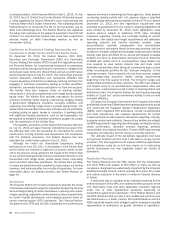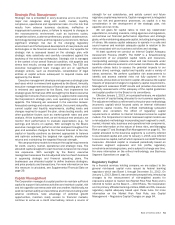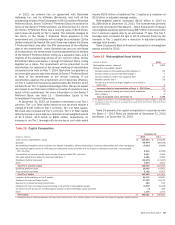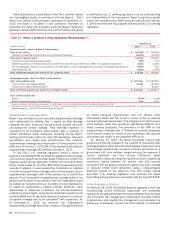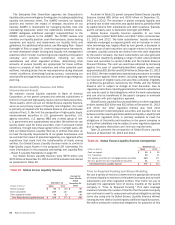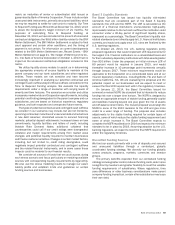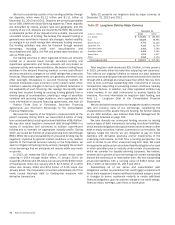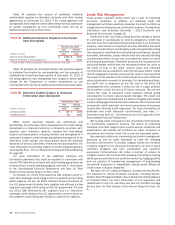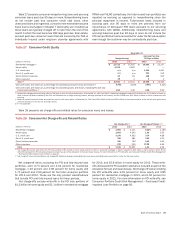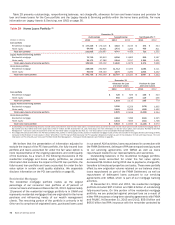Bank of America 2013 Annual Report Download - page 68
Download and view the complete annual report
Please find page 68 of the 2013 Bank of America annual report below. You can navigate through the pages in the report by either clicking on the pages listed below, or by using the keyword search tool below to find specific information within the annual report.
66 Bank of America 2013
Table 18 presents a reconciliation of our Tier 1 common capital
and risk-weighted assets in accordance with the Basel 1 – 2013
Rules to our Basel 3 fully phased-in estimates at December 31,
2013 and Basel 1 to Basel 3 fully phased-in estimates at
December 31, 2012. Our estimates under the Basel 3 Advanced
approach may be refined over time as a result of further rulemaking
or clarification by U.S. banking regulators or as our understanding
and interpretation of the rules evolve. Basel 3 regulatory capital
metrics are considered non-GAAP financial measures until January
1, 2014 when they are fully adopted and required by U.S. banking
regulators.
Table 18 Basel 1 to Basel 3 (fully phased-in) Reconciliation (1)
December 31
(Dollars in millions) 2013 2012
Regulatory capital – Basel 1 to Basel 3 (fully phased-in)
Basel 1 Tier 1 capital $ 161,456 $ 155,461
Deduction of qualifying preferred stock and trust preferred securities (16,221) (22,058)
Basel 1 Tier 1 common capital 145,235 133,403
Deduction of defined benefit pension assets (829)(737)
Deferred tax assets and threshold deductions (deferred tax asset temporary differences, MSRs and significant investments) (4,803)(3,020)
Net unrealized gains (losses) in accumulated OCI on AFS debt and certain marketable equity securities, and employee benefit plans (5,668)449
Other deductions, net (1,620)(1,469)
Basel 3 Advanced approach (fully phased-in) Tier 1 common capital $ 132,315 $ 128,626
Risk-weighted assets – Basel 1 to Basel 3 (fully phased-in)
Basel 1 risk-weighted assets $ 1,297,534 $ 1,205,976
Credit and other risk-weighted assets 31,510 103,085
Increase due to Market Risk Final Rule (2) —81,811
Basel 3 Advanced approach (fully phased-in) risk-weighted assets $ 1,329,044 $ 1,390,872
Tier 1 common capital ratios
Basel 1 11.19% 11.06%
Basel 3 Advanced approach (fully phased-in) 9.96 9.25
(1) Includes the Market Risk Final Rule at December 31, 2013. Basel 1 did not include the Market Risk Final Rule at December 31, 2012.
(2) Excludes the benefit of certain hedges at December 31, 2012. Including these hedges, the increase due to the Market Risk Final Rule would have been $78.8 billion. For additional information, see
Capital Management – Capital Composition and Ratios on page 62.
Supplementary Leverage Ratio
Basel 3 also will require us to calculate a supplementary leverage
ratio, determined by dividing Tier 1 capital by total leverage
exposure for each month-end during a fiscal quarter, and then
calculating the simple average. Total leverage exposure is
comprised of all on-balance sheet assets, plus a measure of
certain off-balance sheet exposures, including among others,
lending commitments, letters of credit, OTC derivatives, repo-style
transactions and margin loan commitments. The minimum
supplementary leverage ratio requirement of three percent is not
effective until January 1, 2018. We will be required to disclose our
supplementary leverage ratio effective January 1, 2015.
In July 2013, U.S. banking regulators issued a notice of
proposed rulemaking (NPR) to modify the supplementary leverage
ratio minimum requirements under Basel 3 effective in 2018. This
proposal would only be applicable to BHCs with more than $700
billion in total assets or more than $10 trillion in total assets under
custody. If adopted, it would require the Corporation to maintain
a minimum supplementary leverage ratio of three percent, plus a
supplementary leverage buffer of two percent, for a total of five
percent. If the Corporation’s supplementary leverage buffer is not
greater than or equal to two percent, then the Corporation would
be subject to mandatory limits on its ability to make distributions
of capital to shareholders, whether through dividends, stock
repurchases or otherwise. In addition, the insured depository
institutions of such BHCs, which for the Corporation would include
primarily BANA and FIA, would be required to maintain a minimum
six percent leverage ratio to be considered “well capitalized.” As
of December 31, 2013, we estimate the Corporation’s
supplementary leverage ratio to be in excess of five percent based
on these proposed requirements, and our primary bank
subsidiaries, BANA and FIA, to be in excess of the six percent
minimum proposed requirement. The proposal is not yet final and,
when finalized, could have provisions significantly different from
those currently proposed. The provisions of the NPR on the
supplementary leverage ratio, if finalized as currently proposed,
could have an impact on certain of our businesses. We continue
to evaluate the impact of the proposed NPR on us.
On January 12, 2014, the Basel Committee issued final
guidance introducing changes to the method of calculating total
leverage exposure under the international Basel 3 framework. The
total leverage exposure was revised to measure derivatives on a
gross basis with cash variation margin reducing the exposure if
certain conditions are met, include off-balance sheet
commitments measured using the notional amount multiplied by
conversion factors between 10 percent and 100 percent
consistent with the general risk-based capital rules and a change
to measure written credit derivatives using a notional-based
approach capped at the maximum loss with limited netting
permitted. U.S. banking regulators may consider the Basel
Committee’s final guidance in connection with the July 2013 NPR.
Other Regulatory Matters
On February 18, 2014, the Federal Reserve approved a final rule
implementing certain enhanced supervisory and prudential
requirements established under the Financial Reform Act. The final
rule formalizes risk management requirements primarily related
to governance and liquidity risk management and reiterates the
provisions of previously issued final rules related to risk-based


